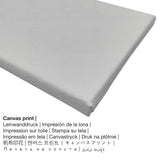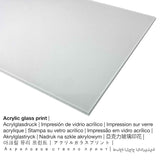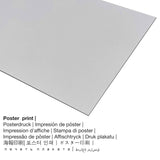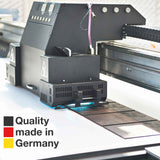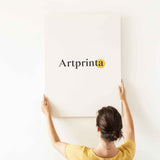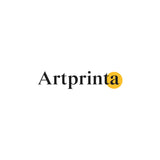Amaghị, 1817 - Eserese nke ezinụlọ Cock Blomhoff - mbipụta nka mara mma
Ụtụ gụnyere. Mbupu gbakọrọ na ndenye ọpụpụ.
Ozi ndabere na akụkọ
Portrait of the Cock Blomhoff Family was made by the artist Unknown in the year 1817. Ọzọkwa, a pụrụ ịhụ mpempe nka ahụ n'ime Rijksmuseum's nchịkọta nka dijitalụ, nke dị na Amsterdam, Netherlands. Site n'ikike nke: Rijksmuseum (licensed - public domain).: . In addition to this, the alignment of the digital reproduction is landscape and has a ratio of 2: 1, nke pụtara na ogologo ya dị okpukpu abụọ karịa obosara.
Nye iwu ihe ị họọrọ
In the dropdown menu next to the product offering you can select the size and material of your choice. You can choose among the following product customization options:
- Kwaaji: The canvas print is a printed canvas stretched on a wooden stretcher. A canvas generates the plastic impression of three dimensionality. What is more, printed canvas produces a soft and enjoyable look. The advantage of canvas prints is that they are relatively low in weight, which means that it is easy to hang your Canvas print without the help of extra wall-mounts. A canvas print is suited for all types of walls.
- Mbipụta iko acrylic na-egbuke egbuke (nke nwere ezigbo mkpuchi iko): The print on acrylic glass, often named a print on plexiglass, will turn your favorite original artwork into beautiful home décor and is a viable alternative option to dibond and canvas prints. Your artwork is being custom-made thanks to the help of modern UV direct printing machines. The major benefit of an acrylic glass art print is that sharp contrasts plus image details will be more identifiable with the help of the subtle tonal gradation. The acrylic glass protects your selected art print against light and heat for many years.
- Akwụkwọ mmado ebipụtara (akwa akwa akwa): Our poster print is a printed canvas paper with a fine texture on the surface. Please note, that depending on the size of the poster print we add a white margin of around 2-6cm around the painting in order to facilitate the framing with your custom frame.
- Mbipụta nke aluminom: This is a metal print made on aluminium dibond with a true effect of depth, which creates a modern impression by having a non-reflective surface structure. The direct print on aluminium is the most popular entry-level product and is an extremely stylish way to showcase art prints, as it puts all of the viewer’s focus on the image.
Disclaimer: We try everythig possible to depict the art products as accurately as possible and to exhibit them visually on the product detail pages. At the same time, the tone of the print materials and the print result may diverge slightly from the image on your monitor. Depending on the settings of your screen and the quality of the surface, colors can unfortunately not be printed one hundret percent realistically. In view of the fact that the are processed and printed manually, there may also be slight differences in the motif's exact position and the size.
Nkọwa ngwaahịa
| Nkewa ngwaahịa: | ọrụ mgbidi |
| Mmeputakwa: | dijitalụ mmeputakwa |
| Usoro mmepụta: | Mbipụta UV / dijitalụ |
| Production: | German mere |
| Stockdị ngwaahịa: | na mmepụta ihe |
| Eji ngwaahịa a chọrọ: | ime ụlọ, ihe ndozi ụlọ |
| Ndozi onyonyo a: | usoro odida obodo |
| Njikwa oyiyi: | ogologo ruo obosara 2: 1 |
| Mmetụta ihe onyonyo: | ogologo ahụ dị okpukpu abụọ karịa obosara |
| Ngwa ngwaahịa dị: | Mpempe iko acrylic (nke nwere ezigbo mkpuchi iko), mbipụta ọla (aluminium dibond), mbipụta akwụkwọ mmado (akwụkwọ kwaaji), mbipụta kwaaji. |
| Mpempe akwa akwa (akwa akwa na etiti ihe ndọtị) nha: | 40x20cm - 16x8 ", 60x30cm - 24x12", 80x40cm - 31x16", 100x50cm - 39x20", 120x60cm - 47x24", 160x80cm - 63x31" |
| Mbipụta iko acrylic (nke nwere ezigbo mkpuchi iko): | 40x20cm - 16x8 ", 60x30cm - 24x12", 80x40cm - 31x16", 100x50cm - 39x20", 120x60cm - 47x24", 160x80cm - 63x31" |
| Mpempe akwụkwọ mmado (akwụkwọ kwaaji) nha: | 60x30cm - 24x12", 80x40cm - 31x16", 100x50cm - 39x20", 120x60cm - 47x24" |
| Nhọrọ aluminom dibond (ihe aluminom) nhọrọ: | 40x20cm - 16x8", 60x30cm - 24x12", 80x40cm - 31x16", 100x50cm - 39x20", 120x60cm - 47x24" |
| Nhazi mbipụta nka: | mmeputakwa na-enweghị isi |
Nkọwa nka ahaziri
| Aha nka nka: | "Portrait of the Cock Blomhoff Family" |
| Nhazi: | sere |
| Nhazi nka: | nkà nke oge a |
| Narị afọ nka: | 19th narị afọ |
| Afọ okike: | 1817 |
| Afọ nka: | ihe dị ka afọ 200 |
| Ụlọ ihe ngosi nka / ebe: | Rijksmuseum |
| Ebe ngosi nka: | Amsterdam, Netherlands |
| Weebụsaịtị ihe ngosi nka: | Rijksmuseum |
| Akwụkwọ ikike nka: | ngalaba ọha |
| Site n'aka: | Rijksmuseum |
Ozi ndabere na onye na-ese ihe
| Aha onye nka: | Unknown |
| Ọrụ: | onye na-ese ihe |
| nhazi ọkwa: | omenkà nke oge a |
Nwebiisinka © - www.artprinta.com (Artprinta)
Ozi izizi gbasara ọrụ nka sitere na webụsaịtị ihe ngosi nka (© - Rijksmuseum - Rijksmuseum)
When the director Jan Cock Blomhoff travelled to Japan in 1817, he did something highly unusual: he took along his family. Western women were not allowed onto Deshima. Titia and her young son thus had to leave the country a few months later. A Japanese artist portrayed the family. From left to right are: Jan Cock Blomhoff, the wetnurse Petronella Munts, Titia Cock Blomhoff-Bergsma, her son Jan and two Javanese servants.


